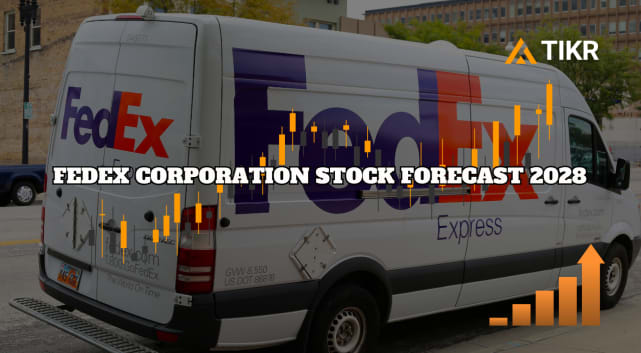Union Pacific Corporation (NYSE: UNP) has traded lower this year as freight volumes softened and industrial demand stayed uneven. The stock sits around $222/share, down about 7% over the past year. Still, analysts see potential recovery ahead, supported by cost control, strong margins, and steady cash flow.
Recently, Union Pacific reported quarterly results that topped profit expectations, helped by higher pricing and efficiency gains under CEO Jim Vena’s leadership. The company has also been investing heavily in automation and precision scheduling to improve service reliability and reduce costs, positioning itself for a leaner, more productive rail network going into 2025.
This article explores where Wall Street analysts think Union Pacific could trade by 2027. We have pulled together consensus targets and valuation models to outline the stock’s potential path. These figures reflect current analyst expectations and are not TIKR’s own predictions.
Unlock our Free Report: 5 AI compounders that analysts believe are undervalued and could deliver years of outperformance with accelerating AI adoption (Sign up for TIKR, it’s free) >>>
Analyst Price Targets Suggest Modest Upside
Union Pacific trades near $222/share today. The average analyst price target is $262/share, which points to roughly 16% upside over the next year. Forecasts remain fairly tight, showing moderate confidence in the recovery outlook:
- High estimate: ~$298/share
- Low estimate: ~$213/share
- Median target: ~$263/share
- Ratings: 14 Buys, 2 Outperforms, 11 Holds
For investors, this points to modest upside if freight demand stabilizes and margin expansion continues. Analysts are not expecting a breakout, but they see room for steady gains supported by cost efficiency, disciplined spending, and improving service reliability. Union Pacific’s strong profitability gives it flexibility to navigate short-term softness while continuing to compound value over time.

See analysts’ growth forecasts and price targets for Union Pacific (It’s free!) >>>
Union Pacific: Growth Outlook and Valuation
The company’s fundamentals appear stable, supported by solid pricing power and cost discipline:
- Revenue is projected to grow about 3% annually through 2027
- Operating margins are expected to reach roughly 42%
- Shares trade at around 19× forward earnings, in line with historical averages
- Based on analysts’ average estimates, TIKR’s Guided Valuation Model using a 19× forward P/E suggests about $258/share by 2027
- That implies roughly 14% total upside, or about 6% annualized returns
These numbers suggest Union Pacific can compound steadily over the next few years, but without dramatic growth. The stock looks fairly valued today, which means future returns depend on maintaining high efficiency and stable freight demand.
For investors, Union Pacific offers a mix of dependability and steady income, making it an attractive choice for those who prioritize consistency and long-term capital preservation over rapid expansion.

Value stocks like Union Pacific in as little as 60 seconds with TIKR (It’s free) >>>
What’s Driving the Optimism?
Union Pacific remains one of the most efficient rail operators in North America. The company has steadily improved service reliability and cost structure through its precision-scheduled rail strategy, while automation and technology investments continue to support productivity.
Freight demand across industrial and agricultural markets is showing signs of stability, and management’s ongoing focus on network optimization should sustain healthy cash generation. For investors, these strengths suggest Union Pacific is well positioned to protect margins and gradually rebuild earnings momentum.
Bear Case: Volume Risk and Valuation Limits
Despite its strengths, Union Pacific still faces challenges. Freight volumes are cyclical and sensitive to U.S. industrial activity, meaning a slowdown in manufacturing or energy shipments could weigh on performance. The company also operates in a capital-intensive environment where inflation and labor costs can pressure margins.
At around 19× forward earnings, the stock already trades close to its long-term average. For investors, this means much of the recovery story may already be priced in. Upside could be limited unless Union Pacific delivers stronger volume growth or further cost savings beyond current expectations.
Outlook for 2027: What Could Union Pacific Be Worth?
Based on analysts’ average estimates, TIKR’s Guided Valuation Model using a 19× forward P/E suggests Union Pacific could reach about $258/share by 2027. That implies roughly 14% total upside, or about 6% annualized returns from today’s levels.
For investors, that points to steady compounding potential rather than fast growth. Union Pacific’s operational discipline and consistent free cash flow make it a reliable choice for those seeking stable long-term exposure to U.S. infrastructure and freight logistics. If management continues improving efficiency and cost control, the stock could modestly outperform current expectations.
AI Compounders With Massive Upside That Wall Street Is Overlooking
Everyone wants to cash in on AI. But while the crowd chases the obvious names benefiting from AI like NVIDIA, AMD, or Taiwan Semiconductor, the real opportunity may lie on the AI application layer where a handful of compounders are quietly embedding AI into products people already use every day.
TIKR just released a new free report on 5 undervalued compounders that analysts believe could deliver years of outperformance as AI adoption accelerates.
Inside the report, you’ll find:
- Businesses already turning AI into revenue and earnings growth
- Stocks trading below fair value despite strong analyst forecasts
- Unique picks most investors haven’t even considered
If you want to catch the next wave of AI winners, this report is a must-read.
Click here to sign up for TIKR and get your free copy of TIKR’s 5 AI Compounders report today.







